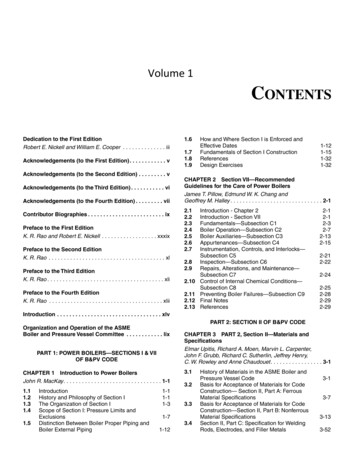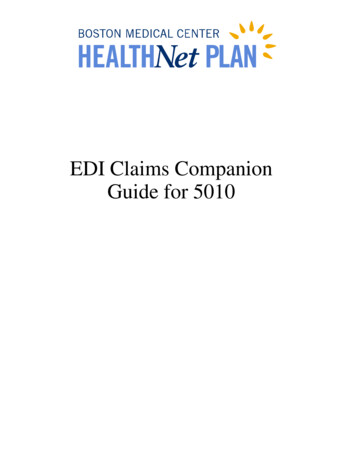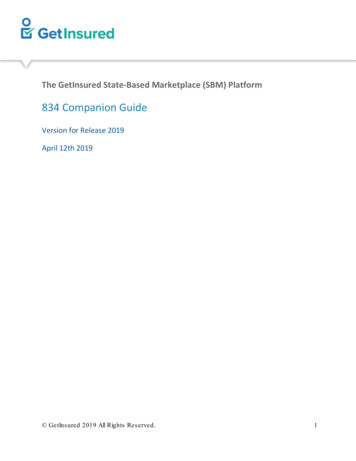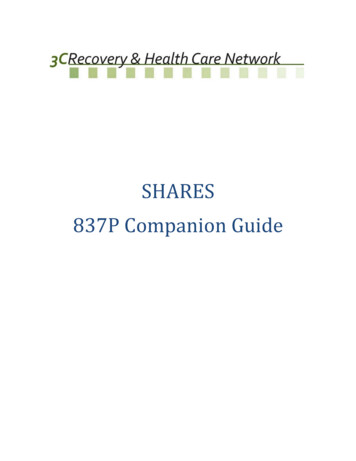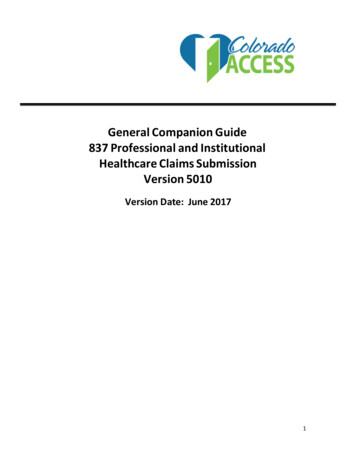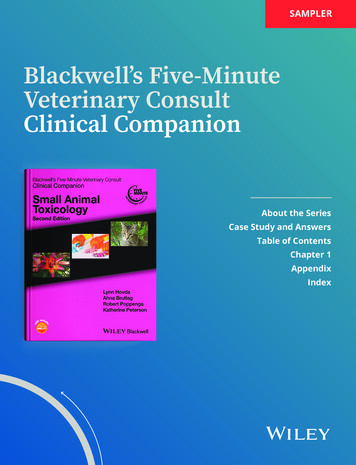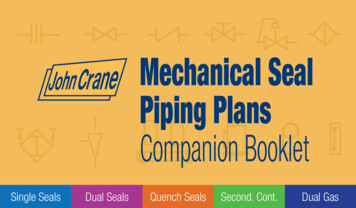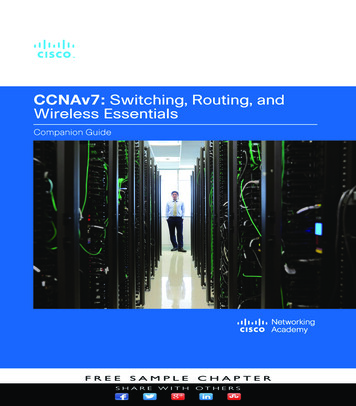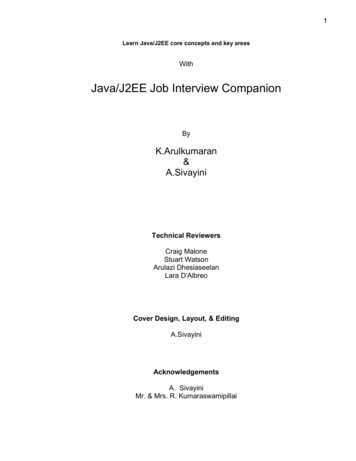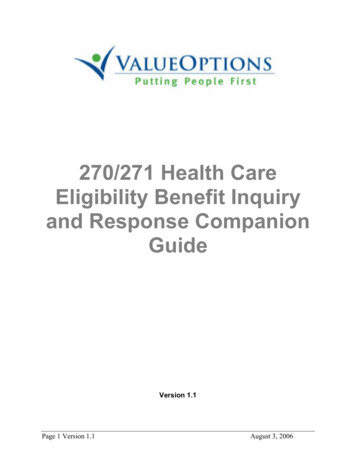
Transcription
270/271 Health CareEligibility Benefit Inquiryand Response CompanionGuideVersion 1.1Page 1 Version 1.1August 3, 2006
TABLE OF CONTENTSINTRODUCTIONPURPOSESPECIAL CONSIDERATIONSInbound Transactions SupportedResponse Transactions SupportedDelimiters SupportedSearch CriteriaInquiry/Response Level SupportedMaximum LimitationsDefinition of TermsTelecommunication SpecificationsCompliance Testing SpecificationsTrading Partner Acceptance Testing SpecificationsINTERCHANGE CONTROL HEADER SPECIFICATIONS (270 TRANSACTION)INTERCHANGE CONTROL TRAILER SPECIFICATIONS (270 TRANSACTION)FUNCTIONAL GROUP HEADER SPECIFICATIONS (270 TRANSACTION)FUNCTIONAL GROUP TRAILER SPECIFICATIONS (270 TRANSACTION)270 HEALTH CARE ELIGIBILITY BENEFIT INQUIRY TRANSACTION SPECIFICATIONSINTERCHANGE CONTROL HEADER SPECIFICATIONS (271 TRANSACTION)INTERCHANGE CONTROL TRAILER SPECIFICATIONS (271 TRANSACTION)FUNCTIONAL GROUP HEADER SPECIFICATIONS (271 TRANSACTION)FUNCTIONAL GROUP TRAILER SPECIFICATIONS (271 TRANSACTION)271 HEALTH CARE ELIGIBILITY BENEFIT RESPONSE TRANSACTIONSPECIFICATIONSPage 2 Version 1.133333344456679111214152124252728August 3, 2006
INTRODUCTIONIn an effort to reduce the administrative costs of health care across the nation, the HealthInsurance Portability and Accountability Act (HIPAA) was passed in 1996. This legislationrequires that health insurance payers in the United States comply with the electronic datainterchange (EDI) standards for health care, established by the Secretary of Health and HumanServices (HHS). For the health care industry to achieve the potential administrative cost savingswith EDI, standard transactions and code sets have been developed and need to be implementedconsistently by all organizations involved in the electronic exchange of data. The ANSI X12N270/271 Health Care Eligibility Benefit Inquiry and Response transactions implementation guideprovides the standardized data requirements to be implemented for all health care eligibilitybenefit inquiries and responses conducted electronically.PURPOSEThe purpose of this document is to provide the information necessary to submit an eligibilitybenefit inquiry and receive an eligibility benefit response electronically to/from ValueOptions, Inc.This companion guide is to be used in conjunction with the ANSI X12N implementation guides.The companion guide supplements, but does not contradict or replace any requirements in theimplementation guide. The implementation guides can be obtained from the WashingtonPublishing Company by calling 1-800-972-4334 or are available for download on their web site athttp://www.wpc-edi.com/hipaa/ . Other important websites:Workgroup for Electronic Data Interchange (WEDI) – http://www.wedi.orgUnited States Department of Health and Human Services (DHHS) – http://aspe.hhs.gov/Centers for Medicare and Medicaid Services (CMS) – http://www.cms.gov/hipaa/hipaa2/Designated Standard Maintenance Organizations (DSMO) – http://www.hipaa-dsmo.org/National Council of Prescription Drug Programs (NCPDP) – http://www.ncpdp.org/National Uniform Billing Committee (NUBC) – http://www.nubc.org/Accredited Standards Committee (ASC X12) – http://www.x12.org/SPECIAL CONSIDERATIONSInbound Transactions SupportedThis section is intended to identify the type and version of the ASC X12 270 Eligibility BenefitInquiry transaction that the health plan will accept. 270 Health Care Eligibility Benefit Inquiry – ASC X12N 270 (004010X092A1)Response Transactions SupportedThis section is intended to identify the response transactions supported by the health plan. TA1 Interchange Acknowledgement997 Functional Acknowledgement271 Health Care Eligibility Benefit Response–ASC X12N 271 (004010X092A1)NOTE: The TA1 and 997 acknowledgements will be supported for real-time transactions.Delimiters SupportedA delimiter is a character used to separate two data elements or sub-elements, or to terminate asegment. Delimiters are specified in the interchange header segment, ISA. The ISA segment is aPage 3 Version 1.1August 3, 2006
105 byte fixed length record. The data element separator is byte number 4; the componentelement separator is byte number 105; and the segment terminator is the byte that immediatelyfollows the component element separator. Once specified in the interchange header, delimitersare not to be used in a data element value elsewhere in the transaction.DescriptionDefault DelimiterData element separator* AsteriskSub-element separator: ColonSegment Terminator TildeValueOptions will support these default delimiters or any delimiter specified by the trading partnerin the ISA/IEA envelope structure.Search CriteriaThe 270 transaction allows the user to provide whatever patient information they have on hand toidentify them to an information source. The Implementation Guide defines a maximum data setthat an information source may require and further identifies additional elements that theinformation source may use, if they are provided, to identify the patient in the information source’ssystem. ValueOptions requires the following elements to uniquely identify a member in theirsystem.Required Search Options: Subscriber’s Member ID Patient’s First Name Patient’s Last Name Patient’s Date of BirthThe Patient’s First and Last Names, although not required, should be provided if available. Theywill assist ValueOptions in identifying the member, if a unique match is not found based on theMember ID and DOB or if one or more of the required elements are unavailable.Inquiry/Response Level SupportedThe 270/271 Health Care Eligibility Benefit Inquiry and Response transaction contains a super setof data segments, elements and codes that represent its full functionality. Receivers of the 271transactions need to design their systems to receive all of the data segments and data elementsidentified in the 271 transactions.However, the information source has the flexibility to determine the amount of informationreturned on the 271-response transaction. The information source is not required to generate anexplicit response to an explicit request, if their system is not capable of handling such requests.At a minimum the information source must support a generic request for eligibility and respondwith either an acknowledgement that the individual has active or inactive coverage or that theindividual was not found in their system. The response will be for the date the transaction isprocessed, unless a specific date was used from the DTP segment of the EQ loop.ValueOptions will support only the basic request for eligibility. Their response will identify theeligibility status of the patient as either active, inactive or not on file for the date requested (or theprocess date of the transaction if no date is specified in the request).Maximum LimitationsThe 270 Health Care Eligibility Benefit Inquiry transaction is designed to inquire on the eligibilitystatus of one or more subscribers/dependents transmitted within the transaction set. The 271Page 4 Version 1.1August 3, 2006
Health Care Eligibility Benefit Response provides the eligibility benefit status for the requestedsubscribers/dependents.In the event that multiple matches are found in the database, ValueOptions will return the AAAsegment used to indicate duplicates found, and if possible provide the missing data elementsnecessary to provide an exact match.The structure of the transaction is as follows:Information SourceInformation ReceiverSubscriberDependent (may be provided if the dependent does not have a uniqueidentifier)Eligibility Benefit (inquiry 270, or information 271)SubscriberEligibility Benefit (inquiry 270, or information 271)Each transaction set contains groups of logically related data in units called segments. Thenumber of times a loop or segment may repeat in the transaction set structure is defined in theimplementation guide.Batch Mode:ValueOptions has no file size limitations. The Interchange Control structure (ISA/IEA envelope)will be treated as one file. Each Interchange Control structure may consist of multiple FunctionalGroups (GS/GE envelopes). ValueOptions requires that the Interchange Control structure islimited to one type of Functional Group, such as 270 Health Care Eligibility Benefit InquiryRequests. ValueOptions will validate and accept or reject the entire Interchange Control structure(ISA/IEA envelope).Batch files will be processed and the response file will be available within 24 hours of receipt.Real-Time Mode:ValueOptions expects a single transaction for only one patient in a real-time inquiry; however,they will not reject a transaction with more than one patient. Response time will be proportionateto the number of patients included in the eligibility inquiry.Definition Of TermsThe participants in the hierarchical level structure described above are as follows: Information Source – The entity that answers the questions being asked in the 270 transaction.The entity that maintains the information regarding the patient’s coverage. The information sourcetypically is the insurer or payer. Information Receiver – The entity that asks the questions in the 270 transaction. Theinformation receiver typically is the medical service provider (i.e. physician, hospital, laboratory,etc. Subscriber – A person who can be uniquely identified to an information source. Traditionallyreferred to as a member.Page 5 Version 1.1August 3, 2006
Dependent – A person who cannot be uniquely identified to an information source, but can beidentified by an information source when associated with a subscriber. Patient – There is no HL loop dedicated to the patient, rather, the patient can be either thesubscriber or the dependent. Different types of information sources identify patients in differentmanners depending upon how their eligibility system is structured.1. Approach 1 – Each member of the family is assigned a unique ID number. In thisapproach, the patient will be identified at the Subscriber hierarchical level because aunique ID number exists to access eligibility information.2. Approach 2 – The actual member (insured) is assigned a number or uses their SSN orEIN to identify the member. Any related spouse, children or dependents are identifiedthrough the subscriber’s identification number. They have no unique identification numberof their own. In this case the patient would be identified at the dependent level inside thesubscriber loop.Telecommunication SpecificationsTrading partners wishing to submit electronic Eligibility Benefit Inquiries (270 transactions) toValueOptions must have a valid ValueOptions Submitter ID/Password. If you do not have aSubmitter ID you may obtain one by completing the Account Request form available on theValueOptions website at ms.htmValueOptions can accommodate multiple submission methods for the 270 Health Care EligibilityBenefit Inquiry transaction. Please refer to the ETS (Electronic Transport System) ElectronicData Exchange Overview document on the ValueOptions website htm for further details.If you have any questions please contact the ValueOptions EDI help desk.E-mail: e-supportservices@valueoptions.comTelephone: 888-247-9311(8am-6pm, Monday-Friday)FAX: 866-698-6032Compliance Testing SpecificationsThe Workgroup for Electronic Data Interchange (WEDI) and the Strategic NationalImplementation Process (SNIP) have recommended seven types HIPAA compliance testing,these are:1. Integrity Testing – This is testing the basic syntax and integrity of the EDI transmission toinclude: valid segments, segment order, element attributes, and numeric values innumeric data elements, X12 syntax and compliance with X12 rules.2. Requirement Testing – This is testing for HIPAA Implementation Guide specific syntaxsuch as repeat counts, qualifiers, codes, elements and segments. Also testing forrequired or intra-segment situational data elements and non-medical code sets whosevalues are noted in the guide via a code list or table.3. Balance Testing – This is testing the transaction for balanced totals, financial balancing ofclaims or remittance advice and balancing of summary fields.4. Situational Testing – This is testing of inter-segment situations and validation ofsituational fields based on rules in the Implementation Guide.5. External Code Set Testing – This is testing of external code sets and tables specifiedwithin the Implementation Guide. This testing not only validates the code value but alsoverifies that the usage is appropriate for the particular transaction.Page 6 Version 1.1August 3, 2006
6. Product Type or Line of Service Testing – This is testing that the segments and elementsrequired for certain health care services are present and formatted correctly. This type oftesting only applies to a trading partner candidate that conducts the specific line ofbusiness or product type.7. Implementation Guide-Specific Trading Partners Testing – This is testing of HIPAArequirements that pertain to specific trading partners such as Medicare, Medicaid andIndian Health. Compliance testing with these payer specific requirements is not requiredfrom all trading partners. If the trading partner intends to exchange transactions with oneof these special payers, this type of testing is required.The WEDI/SNP white paper on Transaction Compliance and Certification and other white papersare found at mlValueOptions’ Recommendations:According to the Centers for Medicare and Medicaid Services (CMS), you are responsible forensuring that your EDI transactions are conducted in compliance with HIPAA regulations. In aneffort to help you address your HIPAA EDI obligations as efficiently as possible, we recommendClaredi , the nation’s leading provider of HIPAA transaction and code set testing andcertification. Claredi is an independent certifying agency, and the only testing and certificationentity selected by CMS for their own compliance. As an additional benefit, using the samecertification organization as ValueOptions greatly reduces the potential for any futurediscrepancies with transactions.Trading Partner Accpetance Testing SpecificationsTo submit a test file to ValueOptions, you must have a valid Submitter ID/Password. Please referto the Telecommunications Specifications section on page 6 of this document for details onobtaining a Submitter ID/Password.When testing the Eligibility Benefit Inquiry transaction (270), for more reliable results, it isrecommended to have the transaction inquire against production data. Please set the UsageIndicator (ISA15) to ‘P’ for Production. The inquiry will then go to the production area to verify theeligibility status of the patient.Page 7 Version 1.1August 3, 2006
Page 8 Version 1.1August 3, 2006270 HEALTH CARE ELIGIBILITY BENEFIT INQUIRYTRANSACTION SPECIFICATIONS
ISASegSecurity Information QualifierSecurity InformationInterchange ID QualifierInterchange Sender IDInterchange ID QualifierInterchange Receiver IDInterchange DateISA02ISA03ISA04ISA05ISA06ISA07ISA08ISA09Page 9 Version 1.1Authorization InformationISA01NameInterchange Control HeaderAuthorization Information QualifierDataElementRRRRRRRRRRAugust 3, 2006Date format YYMMDD.Additional security information identifying the sender.Valid values: ‘00’ No Security Information Present ‘01’PasswordInformation used for additional identification orauthorization.Valid values:‘00’ No Authorization Information Present‘03’ AdditionalData Identification1000095HEADERUsage CommentsINTERCHANGE CONTROL HEADER SPECIFICATIONS (270 TRANSACTION)Refer to the implementationguide specifications.Use ‘FHC &Affiliates’.Refer to the implementationguide for a list of valid qualifiers.Refer to the implementationguide specifications.Use ‘ZZ’ Mutually Defined.Use the ValueOptions submitterID password. Maximum 10characters.Use ‘01’ Password to indicatethat a password will be presentin ISA04.Use the ValueOptions submitterID as the login ID. Maximum 10characters.Use ‘03’ Additional DataIdentification to indicate that alogin ID will be present inISA02.Expected Value
Interchange Control StandardsIdentifierInterchange Control Version NumberInterchange Control NumberAcknowledgement RequestedUsage IndicatorComponent Element SeparatorISA11ISA12ISA13ISA14ISA15ISA16Page 10 Version 1.1Interchange TimeISA10RRRRRRRAugust 3, 2006The delimiter must be a unique character not found in anyof the data included in the transaction set. This elementcontains the delimiter that will be used to separatecomponent data elements within a composite datastructure. This value must be different from the dataelement separator and the segment terminator.Valid values: ‘P’ Production ‘T’ Test .This pertains to the TA1 acknowledgement. Valid values:‘0’ No Acknowledgement Requested ‘1’ InterchangeAcknowledgement RequestedThe interchange control number in ISA13 must beidentical to the associated interchange trailer IEA02.Valid value: ‘00401’ Draft Standards for Trial UseApproved for Publication by ASC X12 Procedures ReviewBoard through October 1997.Code to identify the agency responsible for the controlstandard used by the message. Valid value: ‘U’ U.S. EDICommunity of ASC X12Time format HHMM.ValueOptions will accept anydelimiter specified by the sender.The uniqueness of eachdelimiter will be verified.Use ‘P’ Production.ValueOptions will send a TA1Interchange Acknowledgementfor real-time inquiries only.This value is defined by thesender’s system. If the senderdoes not wish to define a uniqueidentifier zero fill this element.Use the current standardapproved for the ISA/IEAenvelope. Other standards willnot be accepted.Use the value specified in theimplementation guide.Refer to the implementationguide specifications.
IEASegInterchange Control NumberIEA02Page 11 Version 1.1Interchange Control TrailerNumber of Included ust 3, 2006The interchange control number in IEA02 must be identicalto the associated interchange header value sent in ISA13.Count of the number of functional groups in theinterchange.CommentsThe interchange control numberin IEA02 will be compared to thenumber sent in ISA13. If thenumbers do not match the file willbe rejected.This is the count of the GS/GEfunctional groups included in theinterchange structure. Limit theISA/IEA envelope to one type offunctional group i.e. functionalidentifier code ‘HS’ Eligibility,Coverage or Benefit Inquiry(270).Expected Value
GSSegApplication Sender’s CodeApplication Receiver’s CodeDateTimeGroup Control NumberGS02GS03GS04GS05GS06Page 12 Version 1.1Functional Group HeaderFunctional Identifier CodeGS01DataNameElementRRRRRRRAugust 3, 2006The group control number in GS06, must be identical tothe associated group trailer GE02. .Time format HHMM.Date format CCYYMMDD.Code identifying a group of application relatedtransaction sets. Valid value: ‘HS’ Eligibility, Coverageor Benefit Inquiry (270)HEADERUsage CommentsFUNCTIONAL GROUP HEADER SPECIFICATIONS (270 TRANSACTIONThis value is defined by thesender’s system. For real-timeinquiries, ValueOptions will usethis number to identify thefunctional group, if a 997 isgenerated to reject a noncompliantfunctional group.Refer to implementation guidespecifications.Refer to the implementation guidespecifications.The sender defines this value.ValueOptions will not be validatingthis value.This field will identify how the file isreceived by ValueOptions. Use‘EDI’ for electronic transfer.Use the value specified in theimplementation guide.Expected Value
SegVersion/Release Industry ID CodeGS08Page 13 Version 1.1Responsible Agency CodeGS07DataNameElementRRAugust 3, 2006Valid value: Addenda Approved for Publication by ASCX12. ‘004010X092A1’Code identifying the issuer of the standard. Validvalue: ‘X’ Accredited Standards Committee X12Usage CommentsUse the current standardapproved for publication by ASCX12. Ot
The companion guide supplements, but does not contradict or replace any requirements in the implementation guide. The implementation guides can be obtained from the Washington . information receiver typically is the medical service provider (i.e. physician, hospital, laboratory, etc.


